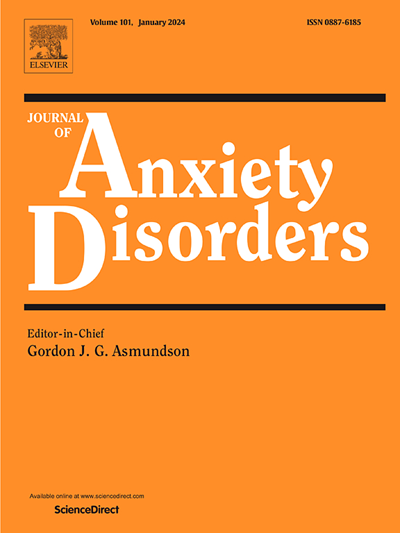使用儿童焦虑评定量表(PARS)评估青少年焦虑症的可靠变化、MCID、治疗反应和缓解
IF 4.5
2区 医学
Q1 PSYCHIATRY
引用次数: 0
摘要
青少年焦虑症是常见的,也是异质性的。儿童焦虑评定量表(PARS)是一种临床医生管理的工具,旨在评估整体焦虑严重程度,独立于特定症状。PARS的可靠变化指数(RCI)、最小临床重要差异(MCID)、治疗反应以及完全和部分缓解的阈值仍不清楚。使用临床总体印象(CGI)量表和诊断访谈作为基准测量,使用904名患有焦虑症的青少年的数据估计了6项PARS的几个阈值,其中36% %被诊断为自闭症。数据来自于在美国进行的9项临床试验。阈值准确性在一个不含样本和一个独立的瑞典样本中进行评估(n = 49)。可靠变化指数(RCI)为3.39点。原始评分降低≥ 4分或≥ 20 %是MCID的最佳定义。原始评分降低≥ 8分或降低≥ 43 %为最佳治疗反应定义。治疗后0-10分准确定义完全缓解和部分缓解,0-5分定义完全缓解。阈值准确度范围从74-91 %在坚持和67-78 %在瑞典样本。不同样本的治疗反应准确性相似,而瑞典样本的MCID准确性较低。在有自闭症和没有自闭症的年轻人中,以及在不同年龄组和性别中,也出现了类似的截止点。5项和7项PARS版本的阈值准确性与6项版本相当。本研究建立了适用于不同年龄组、性别和自闭症状态的PARS的反应和缓解阈值。我们不建议使用RCI,因为它不超过MCID。本文章由计算机程序翻译,如有差异,请以英文原文为准。
Assessing reliable change, MCID, treatment response, and remission using the Pediatric Anxiety Rating Scale (PARS) in youth with anxiety disorders
Youth anxiety disorders are common and heterogeneous. The Pediatric Anxiety Rating Scale (PARS) is a clinician-administered tool designed to assess overall anxiety severity, independent of specific symptoms. The thresholds on PARS for the reliable change index (RCI), the minimal clinically important difference (MCID), treatment response, and full and partial remission remain unclear. Using the Clinical Global Impression (CGI) scales and diagnostic interviews as benchmark measures, several thresholds for the 6-item PARS were estimated using data from 904 youth with anxiety disorders, of which 36 % had an autism diagnosis. Data were drawn from 9 clinical trials conducted in the United States. Threshold accuracy was evaluated in a holdout sample and in an independent Swedish sample (n = 49). The reliable change index (RCI) was 3.39 points. A raw score reduction of ≥ 4 points or a ≥ 20 % reduction best defined the MCID. A raw score reduction of ≥ 8 points or a ≥ 43 % reduction best defined treatment response. Scores of 0–10 after treatment accurately defined full and partial remission, and scores of 0–5 defined full remission. Threshold accuracies ranged from 74–91 % in the holdout and 67–78 % in the Swedish sample. Treatment response accuracy was similar across samples, while MCID accuracy was lower in the Swedish sample. Similar cutoffs emerged in youth with and without autism and across age groups and genders. Threshold accuracies for the 5- and 7-item PARS versions were comparable to the 6-item version. This study establishes response and remission thresholds for PARS that are applicable across age groups, genders, and autism status. We advise against using the RCI as it does not exceed the MCID.
求助全文
通过发布文献求助,成功后即可免费获取论文全文。
去求助
来源期刊

Journal of Anxiety Disorders
Multiple-
CiteScore
16.60
自引率
2.90%
发文量
95
期刊介绍:
The Journal of Anxiety Disorders is an interdisciplinary journal that publishes research papers on all aspects of anxiety disorders for individuals of all age groups, including children, adolescents, adults, and the elderly. Manuscripts that focus on disorders previously classified as anxiety disorders such as obsessive-compulsive disorder and posttraumatic stress disorder, as well as the new category of illness anxiety disorder, are also within the scope of the journal. The research areas of focus include traditional, behavioral, cognitive, and biological assessment; diagnosis and classification; psychosocial and psychopharmacological treatment; genetics; epidemiology; and prevention. The journal welcomes theoretical and review articles that significantly contribute to current knowledge in the field. It is abstracted and indexed in various databases such as Elsevier, BIOBASE, PubMed/Medline, PsycINFO, BIOSIS Citation Index, BRS Data, Current Contents - Social & Behavioral Sciences, Pascal Francis, Scopus, and Google Scholar.
 求助内容:
求助内容: 应助结果提醒方式:
应助结果提醒方式:


